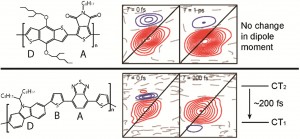Scientists in Canada have used 2D electronic spectroscopy to understand the excitons and charge transfer dynamics (created upon photo excitation) in two conjugated polymers used in organic photovoltaic devices.
The study focuses on the effect of backbone conformation on these properties and the team has found that the weakening of electron-hole correlation controlled by an increasing number of units on the donor and acceptor moieties can lead to higher efficiency of photovoltaic devices by facilitating the charge-transfer process at the heterojunction interfaces.
Although other physical processes should also be taken into account, this study may explain why the photovoltaic devices based not only on the blend of PCDTBT (a popular copolymer for preparing efficient solar cells) and PCBM (an electron acceptor), but also on PCDTBT alone, are efficient.
Link to journal article
Ultrafast relaxation of charge-transfer excitons in low-bandgap conjugated copolymers
I Hwang et al
Chem. Sci., 2012, DOI: 10.1039/c2sc20078c











